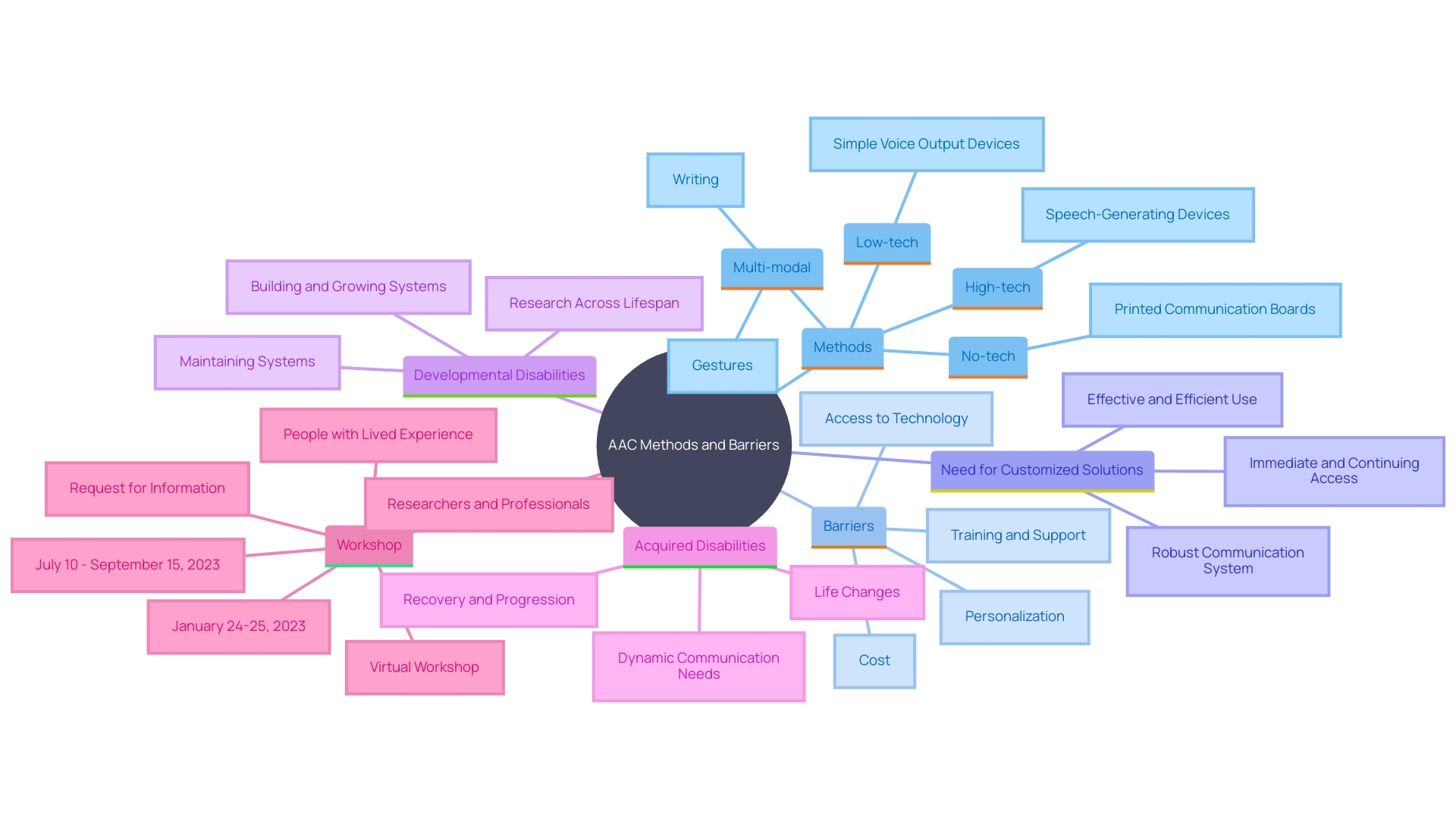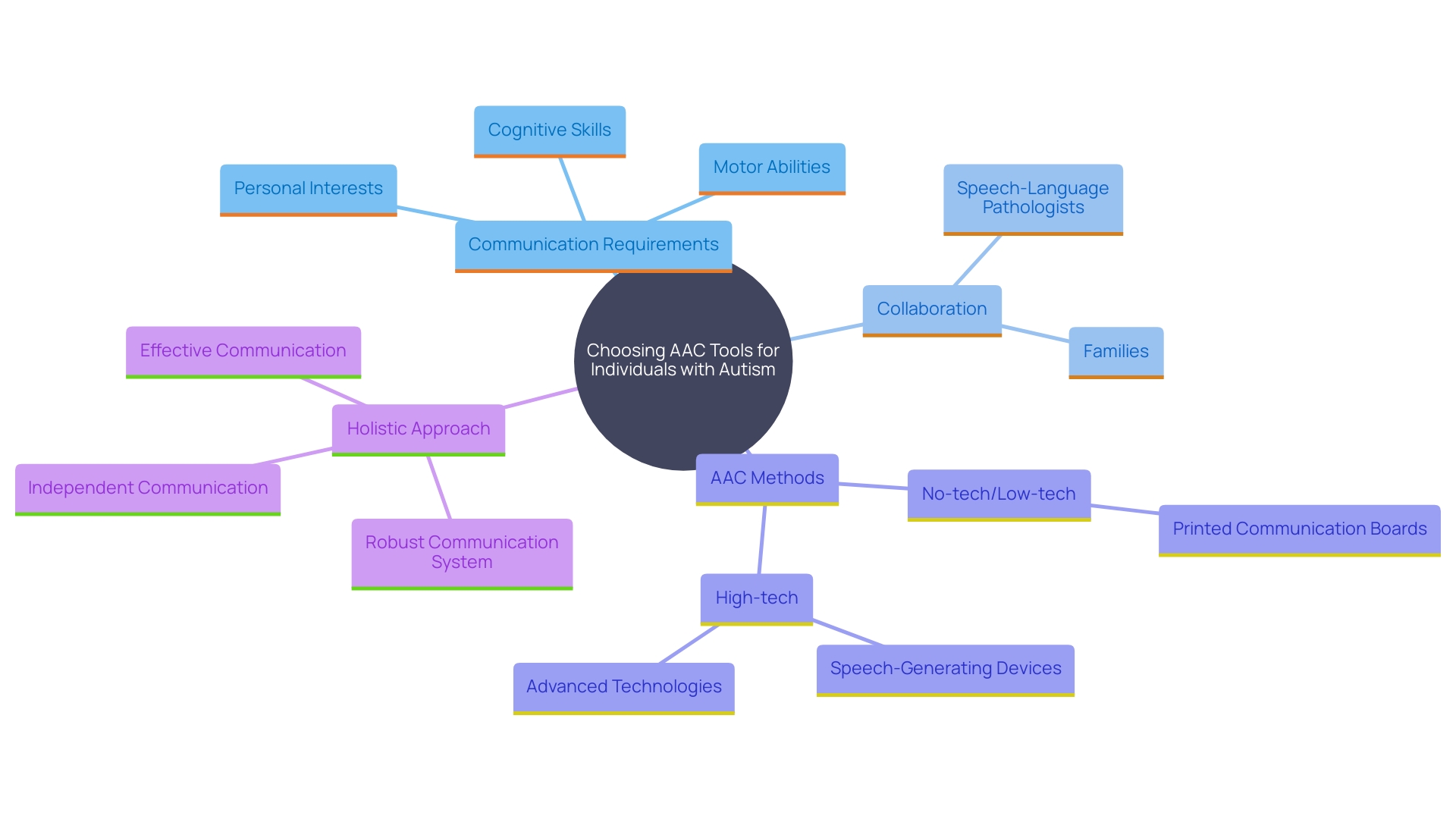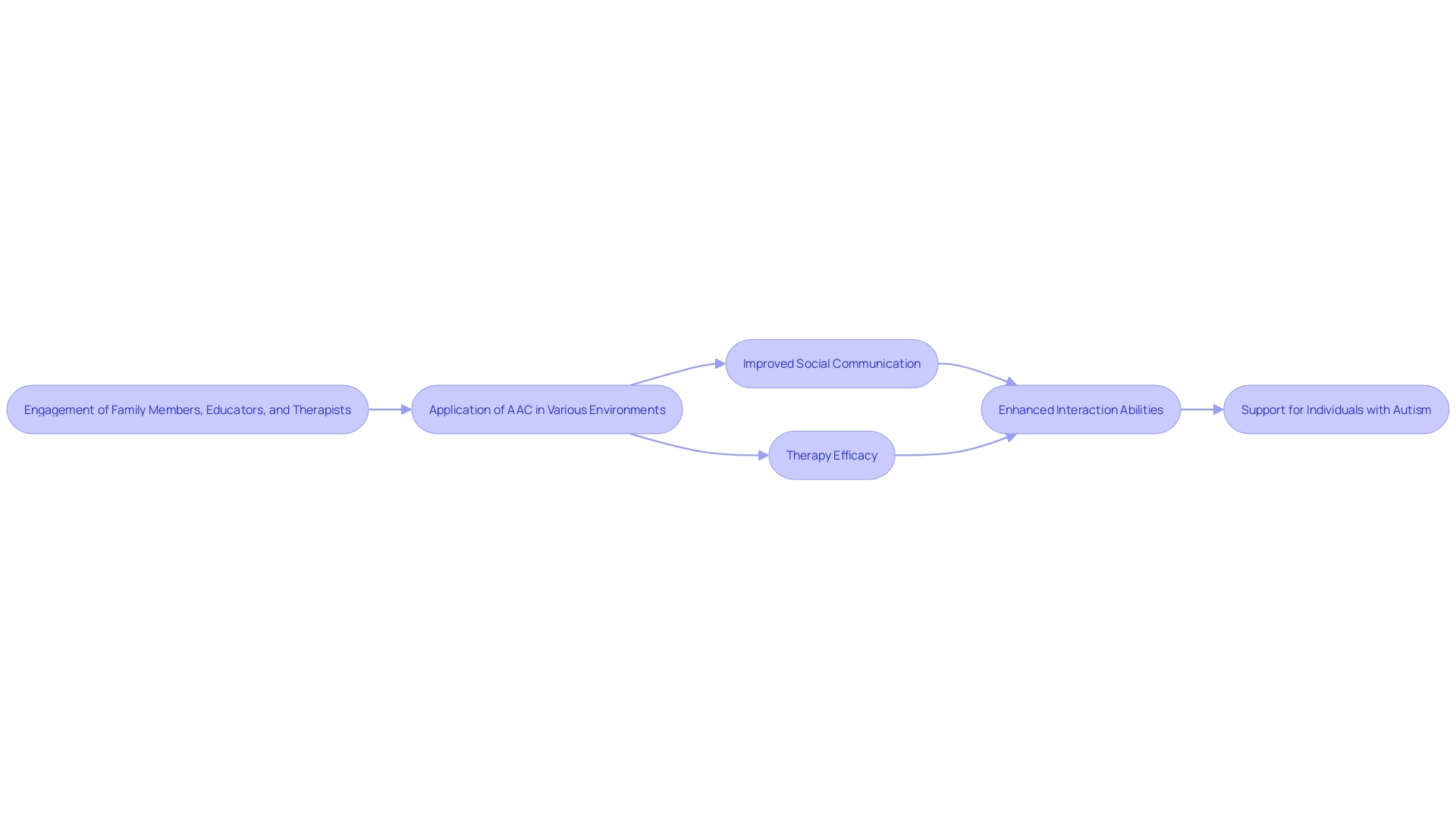Introduction
Communication is a fundamental human right, yet millions of individuals face significant challenges in expressing themselves due to communication disorders. This article delves into the critical role of Augmentative and Alternative Communication (AAC), a transformative approach that supports those who struggle with spoken language. By exploring the diverse methods and devices encompassed by AAC, from low-tech communication boards to high-tech speech-generating devices, the article highlights how tailored solutions can significantly enhance the ability to communicate and engage socially.
Particular attention is given to the benefits of AAC for individuals with autism, underscoring how these devices foster independence, improve social interactions, and support academic achievement. The various types of AAC devices and methods are examined, alongside the essential process of selecting the right device to meet an individual's unique needs. Furthermore, the article outlines practical strategies for implementing AAC in daily life and therapy sessions, ensuring consistent and effective use.
Finally, the future of AAC is explored, with a focus on technological advancements and the potential for personalized, user-friendly devices that can adapt to the evolving needs of individuals. By addressing barriers to access and emphasizing a collaborative approach involving families and professionals, this article aims to empower individuals relying on AAC, ultimately enhancing their quality of life and communication capabilities.
What is Augmentative and Alternative Communication (AAC)?
Augmentative and Alternative Communication (AAC) encompasses diverse methods to support individuals who struggle with spoken language. These methods vary from no-tech or low-tech options like printed information boards to high-tech solutions such as speech-generating devices. AAC also encompasses multi-modal methods, which involve gestures, facial expressions, manual signs, writing, drawing, and selecting photos or written words. By customizing AAC to accommodate each person's unique needs, it significantly improves their ability to express themselves and participate in social interactions.
More than 5 million individuals in the US have language difficulties that prevent them from depending only on spoken words. For these individuals, AAC offers a vital support system, either as a full-time or part-time solution. However, despite its potential benefits, there are numerous barriers to accessing and effectively using AAC. Ideally, those who could benefit from AAC should have immediate and continuous access to a robust system for expressing themselves. This would help establish effective interaction soon after identifying transmission challenges, eventually supporting independent and rich exchanges.
Research highlights the significance of creating and sustaining a strong information exchange framework, particularly for individuals with developmental disabilities, as their requirements change throughout their lives. For individuals with acquired disabilities—whether recuperating or dealing with advancing limitations—it's essential to adjust to their evolving interaction needs. A recent 2-day virtual workshop held in January 2023, along with a request for information active between July and September 2023, aimed to better understand the necessary actions to achieve these goals.
Applications in AAC are anticipated to result in the creation of valid and dependable assessments for research and clinical practice, along with evidence-based methods to enhance interactions between AAC users and their partners. 'This collaborative approach, involving AAC users and their families or caregivers, is essential to enhancing the quality of life for those relying on AAC.'.

Benefits of AAC for Individuals with Autism
AAC tools provide groundbreaking advantages for people with autism, greatly boosting their ability to express themselves, encouraging more independence, and enhancing social interactions. These devices empower people to clearly express their needs, thoughts, and emotions, thereby reducing frustration and challenging behaviors. Moreover, AAC supports language development and serves as an invaluable tool for academic achievement.
One of the key advantages of AAC is its ability to aid interaction when spoken language is limited or unavailable. For many individuals with autism, AAC provides a vital means of interaction, empowering them to participate more fully in daily activities and social settings. By utilizing various methods of interaction—such as gestures, manual signs, speech-generating tools, and picture-based systems—AAC addresses diverse needs and preferences, ensuring a more inclusive environment for sharing information.
Despite these benefits, access to AAC devices and effective implementation can be challenging. Research emphasizes the significance of offering prompt and ongoing access to strong messaging systems after recognizing interaction difficulties. Effective use of AAC requires ongoing support and training for users and their interaction partners, including family members, educators, and speech-language pathologists. This collaborative method guarantees that AAC strategies are customized to personal needs and can adjust as goals and circumstances change.
Recent initiatives, such as a 2-day virtual workshop and a new grant for developing professional development interventions, underscore the commitment to advancing AAC research and practice. These efforts aim to create evidence-based measures and practices that enhance communication between AAC users and their partners, ultimately improving their quality of life.
By tackling obstacles to AAC access and offering extensive assistance, we can unleash the complete capabilities of these tools, enabling people with autism to communicate more efficiently and attain greater autonomy.
Types of AAC Devices and Methods
AAC tools are classified into two primary categories: low-tech and high-tech. Low-tech options consist of boards for interaction and books that utilize symbols or pictures, providing a straightforward way for individuals to express their needs and thoughts. High-tech devices, in contrast, include advanced tools such as speech-generating devices and software applications that enable interaction through touch screens, eye-tracking technology, or even innovative systems like tongue-controlled interfaces. These advanced solutions are created to accommodate a variety of skills and tastes, ensuring that each user can discover an approach that fits their distinct way of expressing themselves.
For example, Augmental's creation of a tongue-controlled interface, known as a "mouthpad," provides an innovative solution for individuals who may struggle with conventional ways of expressing themselves. This Bluetooth-enabled device enables individuals to manage computers, smartphones, or tablets using their tongue, demonstrating the potential of advanced AAC devices to greatly improve interaction abilities.
Moreover, the inclusion of both AAC users and their families in the selection and implementation process is crucial. This collaborative approach aids in developing dependable interaction measures and evidence-based practices that enhance the engagement between AAC users and their partners, ultimately resulting in improved participation and quality of life. Research continues to emphasize the significance of offering prompt and continuous access to strong information exchange systems to assist the changing requirements of people with speech difficulties, whether they are born with developmental disabilities or acquire them later in life.

Choosing the Right AAC Device for Individuals with Autism
Choosing the suitable AAC tool for a person with autism requires a thorough evaluation of their distinct communication requirements, preferences, and capabilities. This process takes into account factors such as cognitive skills, motor abilities, and personal interests, ensuring the selected tool aligns with the individual's goals. Working together with speech-language pathologists and other experts is crucial to improve the effectiveness of the chosen AAC tool.
AAC tools include a range of multi-modal interaction methods, such as gestures, facial expressions, manual signs, writing, drawing, and the use of speech-generating systems. The potential advantages of these devices are substantial, fostering rich and independent interaction. However, barriers to access and effective use must be addressed to maximize their impact.
Evidence suggests that AAC users and their families or caregivers should be actively involved in the selection and implementation process. This collaborative method results in the creation and assessment of dependable interaction strategies and evidence-based practices. For instance, a study emphasized the importance of involving caregivers and people with neurodevelopmental conditions in creating tools for interaction within multisensory settings.
Additionally, the incorporation of advanced technologies, like mobile health applications and digital cognitive evaluation tools, has demonstrated potential in improving interaction for people with autism. These innovations facilitate real-time data collection and analysis, contributing to more personalized and effective AAC interventions.
In conclusion, the thoughtful choice of AAC tools, aided by expert teamwork and the participation of families, can greatly enhance interaction results for people with autism. By utilizing a variety of interaction methods and advanced technologies, we can enable these individuals to articulate their thoughts and needs more effectively.

Implementing AAC in Daily Life and Therapy Sessions
Integrating AAC devices into daily routines and therapy sessions is essential for effective implementation. Regular application in different environments improves interaction abilities, making it essential for family members, educators, and therapists to engage actively. Studies reveal that early interventions, including the use of AAC, significantly improve social communication and reduce core challenges associated with autism. For instance, a framework developed in collaboration with Spazio Autismo demonstrated improved therapy efficacy over four months, highlighting the importance of such interventions. Promoting a supportive atmosphere guarantees that people feel empowered to express themselves, nurturing their growth and autonomy.

The Future of AAC: Technological Advancements and Personalization
The future of AAC is incredibly promising, with ongoing technological advancements paving the way for more personalized and user-friendly tools. 'Innovations such as artificial intelligence, machine learning, and customizable software are significantly enhancing the capabilities of AAC devices, making them more accessible and effective for people with autism.'. For instance, the QuickPic AAC app, developed by experts from Boston Children’s Hospital and an HCI research scientist, demonstrates the power of AI in streamlining communication. This app can quickly generate topic displays by analyzing images and arranging relevant vocabulary, which previously took teachers and speech language pathologists up to half an hour to create.
Furthermore, advancements in eye-tracking and brain-computer interfaces signify the frontier of AAC technology, providing new methods for people with disabilities to engage with the world. These technologies have the potential to transform how people with autism communicate, providing them with new opportunities for connection and expression. However, it is crucial to ensure equitable access to these technologies so that all people who could benefit from AAC have the opportunity to do so, reflecting a broader vision for a more inclusive society.
As technology continues to evolve, the integration of modern tools like AI and machine learning holds immense potential for transforming interaction for those who rely on AAC. Creating strong exchange systems that can adjust to the evolving requirements of people is crucial, and inclusive contributions from researchers and practitioners are important in reaching this objective. The advancements in AAC not only promise a brighter future for individuals with autism but also guide us toward a world where communication knows no bounds.
Conclusion
The exploration of Augmentative and Alternative Communication (AAC) reveals its transformative potential for individuals facing communication challenges, particularly those with autism. By employing a range of methods—from low-tech communication boards to sophisticated speech-generating devices—AAC significantly enhances the ability of individuals to express themselves and engage with their surroundings. The importance of tailored solutions cannot be overstated, as each individual's unique needs and preferences must guide the selection and implementation of AAC devices.
The benefits of AAC extend beyond mere communication; they foster independence, social interaction, and academic achievement. Individuals with autism can express their thoughts and emotions more clearly, reducing frustration and improving overall quality of life. However, access to these devices and ongoing support are critical for maximizing their effectiveness.
Collaboration among families, educators, and professionals is essential to ensure that AAC strategies are dynamic and evolve alongside the individual's needs.
As technology continues to advance, the future of AAC holds great promise. Innovations in artificial intelligence and personalized software are paving the way for more effective and accessible communication tools. It is vital to ensure that equitable access to these technologies is prioritized, enabling all individuals who could benefit from AAC to thrive.
By addressing existing barriers and fostering a collaborative environment, the potential for enhancing communication and independence in individuals with autism can be fully realized, leading to a more inclusive society where everyone can express themselves without limitations.




